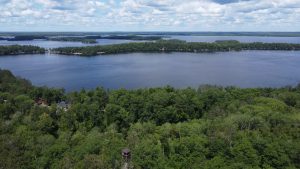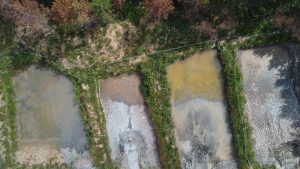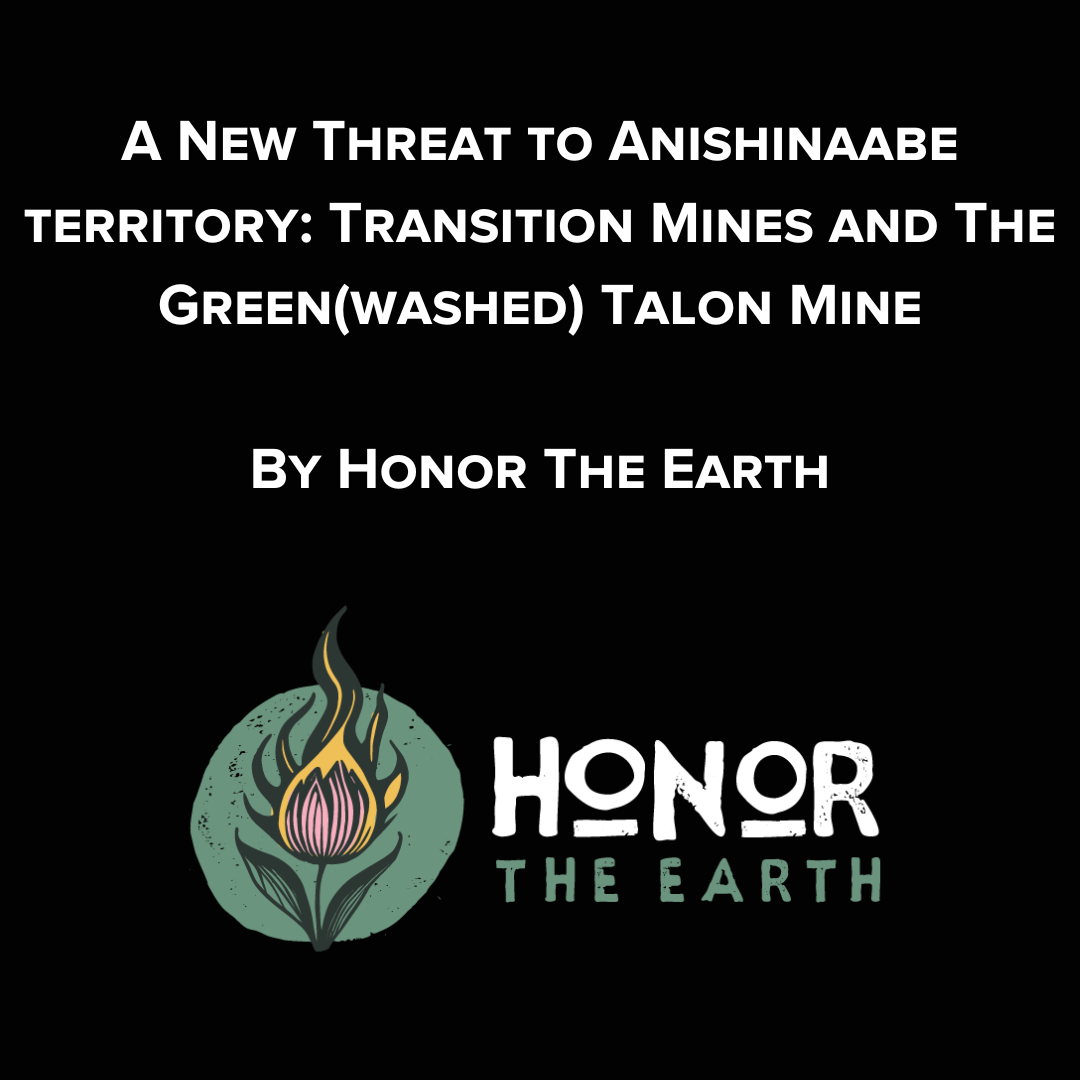A new era of corporate extraction is upon us, this time with a deceptive “green” veil. In the midst of the climate crisis, mining companies are positioning themselves as beneficiaries of the escalating demands for a transition to green energy. They are co-opting legitimate concerns about climate change and disarming and dividing environmental activists by making false claims about “green mining.” Similar to fossil fuel companies, mining companies with long track records of environmental and human rights abuses are subsidized by the federal government. These mining projects continue centuries-long practice of the government backing extractive industries while sacrificing Indigenous lands and communities.

“Transition mines” are being planned all over the country under the premise that to solve climate change, we must focus solely on lowering carbon emissions. Mining companies, like Rio Tinto and Talon Metals claim that we need to extract more metals, such as nickel, from the Earth to build electric vehicles that have a lower carbon footprint. Their formula is more nickel = more EVs = less carbon emissions. This carbon-centric approach to climate action disregards the impacts that dangerous mining has on clean water and ecological health. This oversimplification of the climate crisis allows mining companies to marginalize the concerns of those most impacted by mining. More often than not, it is Indigenous communities who are on the frontlines of these impacts. In fact, 97% of the nickel mining reserves targeted by the U.S. for extraction are located within a 35-mile radius of Native American reservations. The disproportionate impact of mining pollution on Indigenous communities is not coincidental; it is the next phase of a long history of sacrificing Indigenous communities for the sake of corporate greed.
To understand the dangers that “transition mines” pose to Indigenous communities and the environment, look no further than the planned Talon-Rio Tinto mine in the heart of Anishinaabe territory.
The Talon mine, a project by Talon Metals and Rio Tinto, is a nickel-sulfide mine planned in Tamarack, Aitkin County, Minnesota. Talon is saying this will be a “green mine,” because some of the nickel is slated to be used in Tesla’s electric vehicle batteries. Talon also claims they will carefully monitor and minimize the environmental impact of their mine, advertising it as “green nickel” to paint a rosy picture of their operations. Despite these claims, there has never been a sulfide mine that has operated without significant environmental devastation. Sulfide mining is one of the most polluting industries due to the acid mine drainage from sulfide ore coming into contact with air and water, which results in sulfuric acid pollution. These impacts often last for generations if not in perpetuity. To make matters worse, the Talon mine is planned in a complex wetland environment, where the groundwater has not been studied or mapped, increasing risks to water resources and the health of communities that depend on them. One of the most significant concerns is that the region where the mine is planned is home to some of the most productive manoomin, or wild rice, lakes in the world. This manoomin, which is a sacred cultural resource and a vital foodway for Anishinaabe communities, is under attack by the Talon mine.


Talon deflects away from these threats to clean water by pointing to the Eagle Mine, the first U.S. Rio Tinto nickel mine located in the Michigan Upper Peninsula, as a “model mine.” They use false claims of the Eagle Mine’s environmental safety as pretext for the future operations of Talon. Contrary to Talon’s assertions, the Eagle Mine has caused significant pollution since opening in 2014. There have been 17 monitoring events that show levels of pollution outside of the benchmarked range in water permits and exceeding wild rice standards by 1500x. Water levels at the wetland monitoring locations also fell up to six inches below pre-mining baseline levels. The Talon and Eagle projects use similar greenwashing playbooks that emphasize false claims of “green mining technology” and “community consultation.” Talon announced this year that they have begun prospecting in the Michigan Upper Peninsula, meaning that Michiganders now face the potential of two dangerous nickel mines.
Despite claiming to be a small company who cares deeply about local Minnesotans and Michiganders, Talon is a bad actor. They are based in the British Virgin Islands and their most powerful executives are white South Africans with ties to mining projects in the global south and no accountability to the Midwest. Talon Metals serves as a shell company for their joint venture partner, mining giant Rio Tinto. Rio Tinto is infamous for a 150-year history of destruction, ranging from destroying a 46,000-year-old ancient Aboriginal cave system to sparking a civil war in Papua New Guinea. In fact, Rio Tinto was the company behind the Eagle Mine project in the UP which desecrated sacred Eagle Rock despite opposition from Anishinaabe water protectors and other locals. It’s no secret that Rio Tinto is bad news, so they use lesser-known companies like Talon to serve as a buffer that separates them from the public and regulating agencies.
The deceptive structure of using shell companies allows Rio Tinto to dodge public accountability and apply for federal subsidies under the names of their partners. Among these federal subsidies is Biden’s Inflation Reduction Act, which was passed in 2022 and allocates billions of dollars to mining companies. Talon Metals received $115 million from the Department of Energy (DOE) a few months after the passage of this bill. This was the first, but not last, massive federal subsidy that Talon would receive. In September 2023, Talon announced a $21 million grant from the Department of Defense (DOD). Ironically, the Department of Defense is the world’s single largest institutional user of petroleum and thus the largest greenhouse gas emitter. So, while the DOE subsidizes Talon to mitigate greenhouse gas emissions, the DOD simultaneously subsidizes Talon to contribute nickel to its arsenal of polluting machinery. Which one is it Talon? Are you a “green” mine committed to the energy transition, or do you serve the world’s largest polluter? The answer is that Talon will sell to the highest bidder and like their Rio Tinto puppetmaster, disregard environmental and human rights in the process.
The Talon – Rio Tinto mine in Tamarack isn’t the start of some new model of a “sustainable” economy. It’s really just the newest chapter in a long history of violent settler colonialism and exploitation of Anishinaabe lands in the area. In 2021, the Line 3 tar sands pipeline was built just miles from this proposed nickel mine site despite years of fierce resistance from water protectors. During the 19th and 20th centuries, miles and miles of the historic wetlands in this area were drained and turned into agricultural land to promote settlement in the region. During the early settler colonial period, hundreds of Anishinaabe people were forcibly displaced to this region from their homelands further east to clear the land for mining, timber harvesting, and settlement. In 1855 hundreds of people starved to death at Big Sandy Lake where they had been ordered to meet for rations by the US Government who never delivered the food. This historic atrocity, known as the Sandy Lake Massacre, happened just miles from the proposed mine site.
Some Indigenous leaders are calling the proliferation of these “transition” mines Green Colonialism. This term refers to the continuation of centuries of colonial destruction in which corporations, backed by federal dollars, target Indigenous communities and their lands for the sake of profit. Under this lens, the Talon Mine and the threat it poses to manoomin is an extension of a colonial history that profits from disrupting the connection between Indigenous people and their land.
Climate change does pose existential threats and we do need a transition. However, by allowing mining companies to co-opt this transition, we lose focus on the root of the problem. Continued practices of human and environmental extraction under reinforcing systems of capitalism, colonialism, and white supremacy is what got us here in the first place. We must break free of the narrow carbon-centric climate lens and build power at the roots of the issue. Fossil fuels got us here and the myth of “green” mining will not save us. Instead, our transition must focus on repairing relationships with land and fighting for Indigenous sovereignty across the globe. Studies show that when Indigenous people have sovereignty over their land, everybody benefits. Indigenous people protect more than 80% of global biodiversity, despite representing only 6% of the world’s population. The movements for land back and Indigenous sovereignty are fundamental to properly addressing climate change.
Honor the Earth is an Indigenous-led environmental justice organization fighting at the roots of the climate crisis. This means resisting settler colonialism, racial capitalism and white supremacy by supporting frontline struggles against extraction on Turtle Island and around the world. These interventions are based on our belief in a future rooted in Indigenous sovereignty and lifeways, where all people are truly free. Follow us on all social media platforms @honorearth or visit our website at honorearth.org


